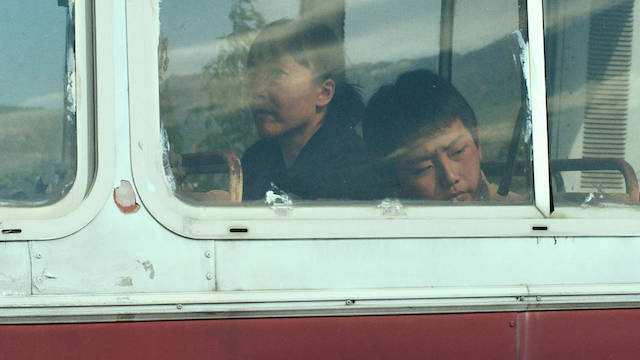Changfeng Town (China, 2019)
Inspired by Gabriel Garcia Marquez’s Macondo town in his novel One Hundred Years of Solitude, Changfeng Town manifests from the nostalgic imagination of Wang Jing, the writer/editor/director of the film with the same title. Wang’s nostalgia, which lies between reality and fantasy, generates an insulated town, sterile from the outside world. As a slice of life film, Changfeng Town never depicts anything outside of town’s vaguely-defined borders. Even when one of the main characters leaves the city and returns later in the story, his life outside of Changfeng Town is never revealed, and therefore irrelevant. We only see his antics before his departure from and after his return to the town.
Time moves in its way while events unfold with its own rules, which sometimes does not follow the logic of our everyday reality, and thus creates a magical aura surrounding this small town. Therefore, it is not surprising that the mystical characteristics of the town dictate the whole film’s sound design, art direction, and cinematography. For example, the magnified sounds of daily town life bring sounds that we usually filter out into the forefront, even more than other realistic-leaning films. Because of the town’s mythic rules, Wang also gives the camera a chance to have dramatic reactions towards traumatic events, which several characters suffer. It is as if the camera also feels the trauma; it pans away from witnessing gory, nauseating, or uncomfortable details of traumatic events, such as when one of the characters finds out that village kids hid dead rats inside a box.
Contrary to commonly used film trope of showing animals and plants as symbols and metaphors for their human counterparts, Wang intentionally creates a symbiotic life between humans, animals, and nature; all of them have their parts to move the plot of the story. Such examples are when a character observes flowers intensely to hear the supposed popping sound of blooming, a character telling the story of plants that move in the night as a part of his backstory, and the town-wide rat infestation that goes on for several story segments.
Inspired by Gabriel Garcia Marquez’s Macondo town in his novel One Hundred Years of Solitude, Changfeng Town manifests from the nostalgic imagination of Wang Jing, the writer/editor/director of the film with the same title. Wang’s nostalgia, which lies between reality and fantasy, generates an insulated town, sterile from the outside world. As a slice of life film, Changfeng Town never depicts anything outside of town’s vaguely-defined borders. Even when one of the main characters leaves the city and returns later in the story, his life outside of Changfeng Town is never revealed, and therefore irrelevant. We only see his antics before his departure from and after his return to the town.
Time moves in its way while events unfold with its own rules, which sometimes does not follow the logic of our everyday reality, and thus creates a magical aura surrounding this small town. Therefore, it is not surprising that the mystical characteristics of the town dictate the whole film’s sound design, art direction, and cinematography. For example, the magnified sounds of daily town life bring sounds that we usually filter out into the forefront, even more than other realistic-leaning films. Because of the town’s mythic rules, Wang also gives the camera a chance to have dramatic reactions towards traumatic events, which several characters suffer. It is as if the camera also feels the trauma; it pans away from witnessing gory, nauseating, or uncomfortable details of traumatic events, such as when one of the characters finds out that village kids hid dead rats inside a box.
Contrary to commonly used film trope of showing animals and plants as symbols and metaphors for their human counterparts, Wang intentionally creates a symbiotic life between humans, animals, and nature; all of them have their parts to move the plot of the story. Such examples are when a character observes flowers intensely to hear the supposed popping sound of blooming, a character telling the story of plants that move in the night as a part of his backstory, and the town-wide rat infestation that goes on for several story segments.
Interestingly, even though the characters live together inside of this town forever, they do not seem to know each other well since each character seems to have their secrets hidden from their family and friends. It is as if they are content to coexist on a nonchalant, prima-facie basis. The best example of this apathy is when the residents live through the establishment and later, shuttering of a dental clinic without much care. Perhaps a cue taken from A Hundred Years of Solitude is the arrival of foreign elements that shake the balance of the town. In Marquez’s masterpiece, nobody dies in the town until a nationwide civil war brought death. While in Wang’s opus, one of the foreign elements is the departure of a dentist and his family. After he sets up his dental clinic, the townspeople start to be concerned with dental hygiene. But after a while, we find out that the still-married doctor has an affair with a town widow. When the anger of the widow’s son causes the clinic to be wrecked and shuttered, torrential rain poured down and left multitudes of dead rats in its wake. Later on, the town displays its composure when they crowd an ice cream cart tended by the dentist after his also nonchalant change of occupation. It seems like the town resists changes but somehow needs to meet outside forces of change midway, just like all of its inhabitants.
Carefully thought out details, well-coached actors—especially the children actors, and Wang’s witty way to reveal an event in connection to another, make it worth your while to see this film. Having won different development grants and received its international premiere at the 2019 Busan International Film Festival, Changfeng Town shows that Wang deserves a place in the list of talented rising Asian female directors.
written by: DR. Azalia Muchransyah, Dosen Prodi Film Binus University.
article published in 2019, http://www.vcinemashow.com/




Comments :